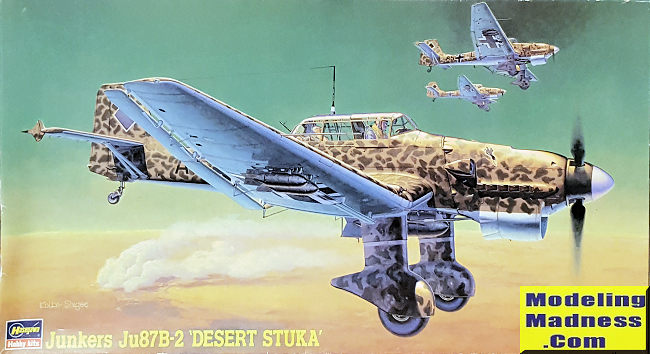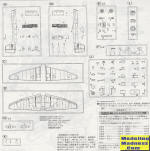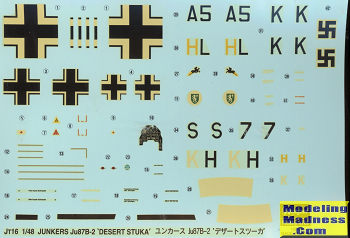
Hasegawa 1/48 Ju-87B-2 'Desert Stuka'
| KIT #: | 09116 (Jt16) |
| PRICE: | 2400 yen SRP |
| DECALS: | Two options |
| REVIEWER: | Scott Van Aken |
| NOTES: | 1994 Limited Edition |

| HISTORY |
The Junkers Ju 87 or Stuka (from Sturzkampfflugzeug, "dive bomber") was a two-man (pilot and rear gunner) German dive bomber and ground-attack aircraft. Designed by Hermann Pohlmann, the Stuka first flew in 1935 and made its combat debut in 1936 as part of the Luftwaffe's Condor Legion during the Spanish Civil War.
The aircraft was easily recognisable by its inverted gull wings, fixed spatted undercarriage and its infamous Jericho-Trompete ("Jericho Trumpet") wailing siren, becoming the propaganda symbol of German air power and the blitzkrieg victories of 1939–1942. The Stuka's design included several innovative features, including automatic pull-up dive brakes under both wings to ensure that the aircraft recovered from its attack dive even if the pilot blacked out from the high acceleration.
Although sturdy, accurate, and very effective against ground targets, the Ju 87 was vulnerable to modern fighter aircraft, like many other dive bombers of the war. Its flaws became apparent during the Battle of Britain; poor manoeuvrability and a lack of both speed and defensive armament meant that the Stuka required heavy fighter escort to operate effectively.
The Stuka operated with further success after the Battle of Britain, and its potency as a precision ground-attack aircraft became valuable to German forces in the Balkans Campaign, the African and Mediterranean theaters and the early stages of the Eastern Front campaigns where Soviet fighter resistance was disorganised and in short supply.
Once the Luftwaffe had lost air superiority on all fronts, the Ju 87 once again became an easy target for enemy fighter aircraft. In spite of this, because there was no better replacement, the type continued to be produced until 1944. By the end of the conflict, the Stuka had been largely replaced by ground-attack versions of the Focke-Wulf Fw 190, but was still in use until the last days of the war. An estimated 6,500 Ju 87s of all versions were built between 1936 and August 1944
| THE KIT |
Armament includes a large centerline bomb and four smaller bombs for the
wings. One needs to open holes for the dive brakes before assembling the wings.
The dive brakes should not be installed until after decals have been applied.
You also need to open holes for the drop tanks if doing the R-2 version. The extensive
canopy is nicely molded and can be posed with the sliding portions open if one
so wishes.  This is one of the many 'special
boxing' kits that are so prevalent from Hasegawa and one of the earliest
as the base kit was released in 1993. In this case, it is the
standard 1/48 Ju-87B kit with the inclusion of a new set of decals. There is basically no difference in this kit and the previous Ju-87B-2
kits. You get
a nicely detailed cockpit that includes the bomb aiming window in the floor in
front of the pilot. A well done gunner/radio operator's section is also part of
the fit. You are also supplied with a nicely done sidewall for the interior. The
most difficult part of my previous build was getting all the forward cowling
bits together, so take care when building this. This kit provides a prop
assembly with separate blades as those were in vogue during the design of this
kit.
This is one of the many 'special
boxing' kits that are so prevalent from Hasegawa and one of the earliest
as the base kit was released in 1993. In this case, it is the
standard 1/48 Ju-87B kit with the inclusion of a new set of decals. There is basically no difference in this kit and the previous Ju-87B-2
kits. You get
a nicely detailed cockpit that includes the bomb aiming window in the floor in
front of the pilot. A well done gunner/radio operator's section is also part of
the fit. You are also supplied with a nicely done sidewall for the interior. The
most difficult part of my previous build was getting all the forward cowling
bits together, so take care when building this. This kit provides a prop
assembly with separate blades as those were in vogue during the design of this
kit.
 Instructions are well done with the usual Gunze paint references. There are
two markings options and frankly, the decals are beyond their 'use by' date. Not
only are the whites a very off-white, but the clear carrier is starting to
yellow. On a dark background it is probably not that much of an issue, but I
simply cannot deal with the off white situation. Fortunately, there are lots of
aftermarket sheets for this. The first option is the box art plane with StG 1 in
1941. This is listed as being a sand and olive green. The other is with StG 3 in
1943 and is listed as being in the same two shades, though the pattern is
significantly different. This latter plane has all the proper white fuselage
band, spinner, and lower wing tips.
Instructions are well done with the usual Gunze paint references. There are
two markings options and frankly, the decals are beyond their 'use by' date. Not
only are the whites a very off-white, but the clear carrier is starting to
yellow. On a dark background it is probably not that much of an issue, but I
simply cannot deal with the off white situation. Fortunately, there are lots of
aftermarket sheets for this. The first option is the box art plane with StG 1 in
1941. This is listed as being a sand and olive green. The other is with StG 3 in
1943 and is listed as being in the same two shades, though the pattern is
significantly different. This latter plane has all the proper white fuselage
band, spinner, and lower wing tips.
| CONCLUSIONS |
Hasegawa kits are notoriously expensive outside of Japan with these kits selling for $35-40 if not more. However, you can get them second had for less. This is one of those. The only issue I had was that there was a major rip in the bag with loose parts rattling around in the box. I do hope all is there as getting replacement part from Hasegawa is a fairly lengthy process. I've only built one of these and that was when it first came out. The kit turned out great. Get canopy masks for it.
| REFERENCES |
http://en.wikipedia.org/wiki/Junkers_Ju_87
January 2021 Copyright ModelingMadness.com.
All rights reserved. If you would like your product reviewed fairly and fairly quickly, please
contact
the editor or see other details in the
Note to
Contributors.